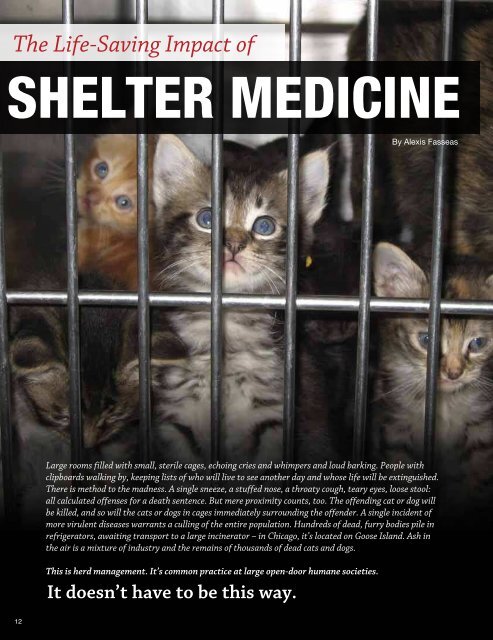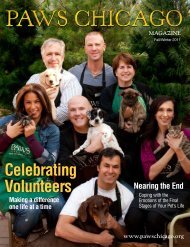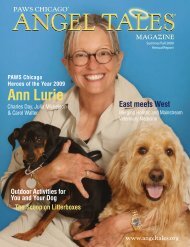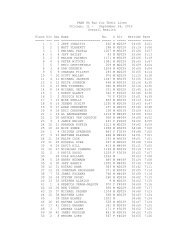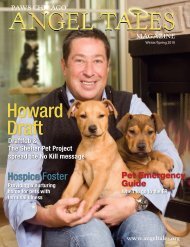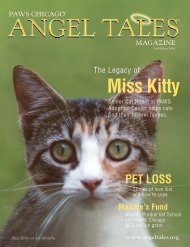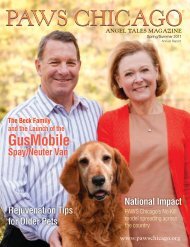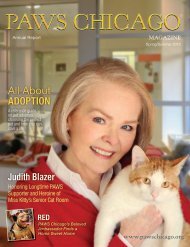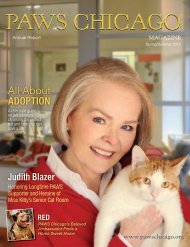DAVID DUFFIELD - PAWS Chicago
DAVID DUFFIELD - PAWS Chicago
DAVID DUFFIELD - PAWS Chicago
Create successful ePaper yourself
Turn your PDF publications into a flip-book with our unique Google optimized e-Paper software.
The Life-Saving Impact of<br />
Shelter Medicine<br />
By Alexis Fasseas<br />
Shelter Medicine<br />
Article Guide<br />
12 Life-Saving Impact of<br />
Shelter Medicine<br />
14 Groundbreaking Work<br />
for the Future of Shelter<br />
Medicine<br />
14 Training Veterinary<br />
Leaders<br />
18 Humane Shelter<br />
Medicine Research<br />
21 Inspiring the Future<br />
Generation of Veterinary<br />
Medicine<br />
22 Putting Shelter Medicine<br />
into Practice<br />
<strong>PAWS</strong> <strong>Chicago</strong>’s Rescue & Recovery Center is the<br />
first stop for all <strong>PAWS</strong> dogs and cats.<br />
Large suites with soft bedding, toys, discreet airflow and piped in<br />
classical music help homeless pets relax and prevent the spread<br />
of disease. An expert shelter medicine veterinary team examines<br />
each pet utilizing a case management approach, diagnosing and<br />
establishing a protocol based on the needs of each individual animal.<br />
Puppies and kittens enjoy the love and socialization of foster homes<br />
until they are able to receive their second vaccination. So do pets with<br />
injuries or illnesses that will require a longer recovery time.<br />
Opposite page: A mama and her kittens await their<br />
fate in a traditional shelter. This page: Lurleen and<br />
Flanders (above left) and Edward (above) in suites<br />
at <strong>PAWS</strong> <strong>Chicago</strong>’s Rescue & Recovery Center.<br />
Large rooms filled with small, sterile cages, echoing cries and whimpers and loud barking. People with<br />
clipboards walking by, keeping lists of who will live to see another day and whose life will be extinguished.<br />
There is method to the madness. A single sneeze, a stuffed nose, a throaty cough, teary eyes, loose stool:<br />
all calculated offenses for a death sentence. But mere proximity counts, too. The offending cat or dog will<br />
be killed, and so will the cats or dogs in cages immediately surrounding the offender. A single incident of<br />
more virulent diseases warrants a culling of the entire population. Hundreds of dead, furry bodies pile in<br />
refrigerators, awaiting transport to a large incinerator – in <strong>Chicago</strong>, it’s located on Goose Island. Ash in<br />
the air is a mixture of industry and the remains of thousands of dead cats and dogs.<br />
This is herd management. It’s common practice at large open-door humane societies.<br />
It doesn’t have to be this way.<br />
The old and out-dated model of<br />
running private shelters as a revolving<br />
door of unlimited intake and frequent<br />
death is being supplanted by the No<br />
Kill movement and the burgeoning<br />
field of shelter medicine. While No Kill<br />
shelters have always been dedicated<br />
to the life of each individual pet in<br />
their care, shelter veterinary protocols<br />
historically mimicked private veterinary<br />
practices. But the David Duffield family’s<br />
foundation Maddie’s Fund had a vision<br />
for a new approach. (Read more about<br />
the Duffield family, recipient of the first<br />
<strong>PAWS</strong> <strong>Chicago</strong> Visionary Award, on<br />
page 26.) Animals living in shelters are<br />
very stressed and exposed to a drastically<br />
different environment than pets living in<br />
a home; treatment needs to be customized<br />
to handle these diverging medical needs.<br />
Additionally, veterinary medicine staff<br />
need to be trained for these specific shelter<br />
circumstances to optimize the health and<br />
management of a large population of<br />
animals and ensure the best care for each<br />
individual pet.<br />
In 2001, Maddie’s Fund established<br />
the nation’s first comprehensive shelter<br />
medicine program at UC Davis, resulting<br />
in the first shelter medicine residency<br />
program and the nation’s first shelter<br />
medicine website. To date, Maddie’s<br />
Fund has funded grants at nine colleges<br />
of veterinary medicine, including<br />
Purdue University, University of Florida<br />
and Cornell University. Just this year<br />
shelter medicine has been accepted as<br />
a recognized specialty by the American<br />
Board of Veterinary Practitioners and<br />
the guidelines for board certification are<br />
currently being developed.<br />
In 2008, Purdue University School of<br />
Veterinary Medicine collaborated with<br />
<strong>PAWS</strong> <strong>Chicago</strong> and received a Maddie’s<br />
Shelter Medicine grant. Maddie’s Fund<br />
also supports <strong>PAWS</strong> <strong>Chicago</strong>’s Shelter<br />
Medicine program with equipment and<br />
veterinary staffing expenses. As a result,<br />
<strong>PAWS</strong> <strong>Chicago</strong> became one of the first<br />
animal welfare organizations in the<br />
Midwest to integrate shelter medicine<br />
into its operations and is a leading shelter<br />
in innovative best practices. Additionally,<br />
leading scientific studies on shelter<br />
medicine are being performed by Purdue<br />
at <strong>PAWS</strong> <strong>Chicago</strong> today. This research will<br />
transform shelter medicine of tomorrow.<br />
12 13


